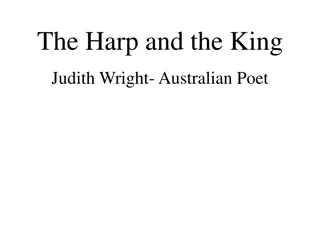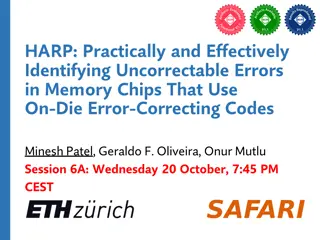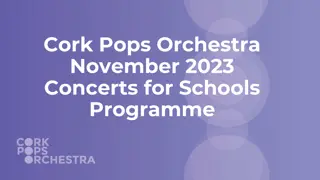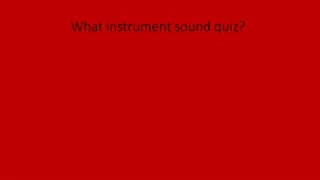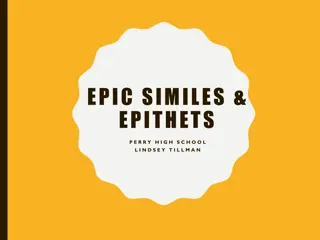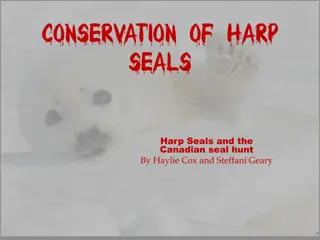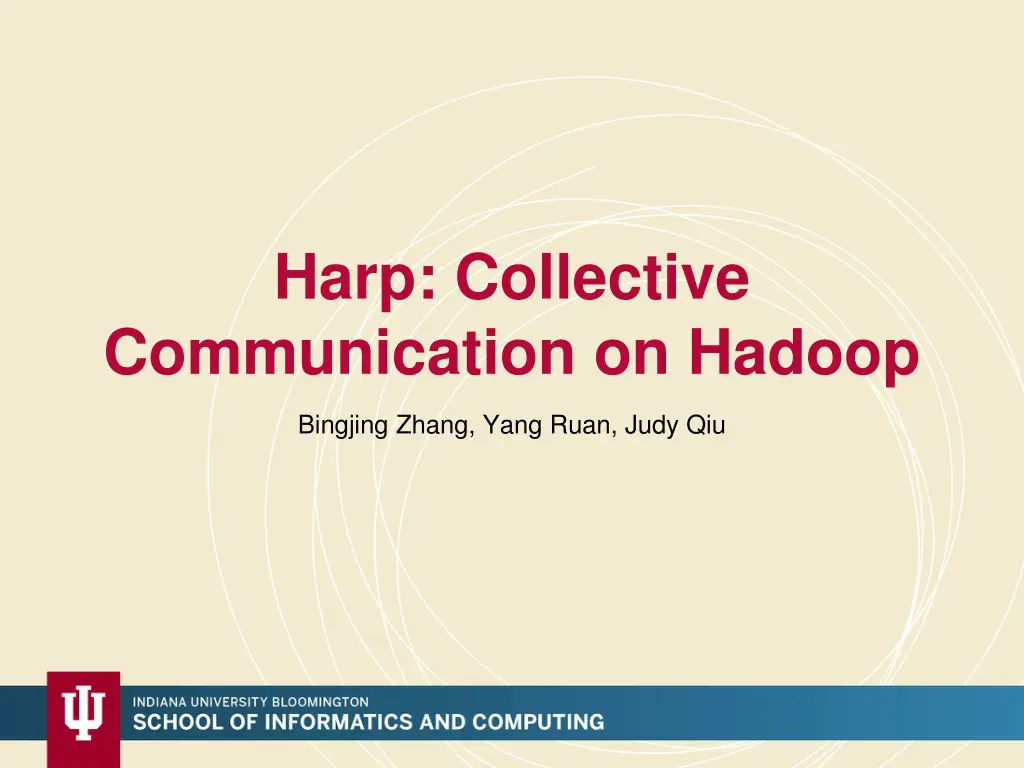
Revolutionizing Big Data Processing with Collective Communication
Explore the groundbreaking approach of using collective communication in Hadoop for optimizing data movement, hierarchical data abstractions, and implementing the MapCollective programming model. Learn about the efficiencies gained, applications in large-scale data analysis, and the models of contemporary big data tools.
Download Presentation

Please find below an Image/Link to download the presentation.
The content on the website is provided AS IS for your information and personal use only. It may not be sold, licensed, or shared on other websites without obtaining consent from the author. If you encounter any issues during the download, it is possible that the publisher has removed the file from their server.
You are allowed to download the files provided on this website for personal or commercial use, subject to the condition that they are used lawfully. All files are the property of their respective owners.
The content on the website is provided AS IS for your information and personal use only. It may not be sold, licensed, or shared on other websites without obtaining consent from the author.
E N D
Presentation Transcript
Harp: Collective Communication on Hadoop Bingjing Zhang, Yang Ruan, Judy Qiu
Outline Motivations Why do we bring collective communications to big data processing? Collective Communication Abstractions Our approach to optimize data movement Hierarchical data abstractions and operations defined on top of them MapCollective Programming Model Extended from MapReduce model to support collective communications Two Level BSP parallelism Harp Implementation A plugin on Hadoop Component layers and the job flow Experiments Conclusion
Motivation More efficient and much simpler! K-means Clustering in (Iterative) MapReduce K-means Clustering in Collective Communication broadcast M M M M M M M M shuffle R R allreduce gather M: Compute local points sum R: Compute global centroids M: Control iterations and compute local points sum
Large Scale Data Analysis Applications Iterative Applications Cached and reused local data between iterations Complicated computation steps Large intermediate data in communications Various communication patterns Computer Vision Complex Networks Deep Learning Bioinformatics
The Models of Contemporary Big Data Tools BSP/Collective Model DAG Model MapReduce Model Graph Model Hadoop HaLoop Giraph Hama GraphLab GraphX For Twister Iterations / Learning Spark Harp Dryad Stratosphere / Flink For Samza S4 Streaming Many of them have fixed communication patterns! Storm Spark Streaming Pig Hive Tez DryadLINQ For Query Spark SQL MRQL
Contributions Parallelism Model Architecture MapCollective Model MapReduce Model MapReduce Applications MapCollective Applications Application M M M M Harp M M M M Framework Shuffle Collective Communication MapReduce V2 R R Resource Manager YARN
Collective Communication Abstractions Hierarchical Data Abstractions Basic Types Arrays, key-values, vertices, edges and messages Partitions Array partitions, key-value partitions, vertex partitions, edge partitions and message partitions Tables Array tables, key-value tables, vertex tables, edge tables and message tables Collective Communication Operations Broadcast, allgather, allreduce Regroup Send messages to vertices, send edges to vertices
Hierarchical Data Abstractions broadcast, allgather, allreduce, regroup, message-to-vertex Array Table <Array Type> Edge Table Message Table Vertex Table Key-Value Table Table Message Partition Array Partition <Array Type> Vertex Partition Edge Partition Key-Value Partition Partition broadcast, send Byte Array Int Array Double Array Long Array Vertices, Edges, Messages Key-Values Array Object Basic Types broadcast, send Transferable
Example: regroup Process 1 Process 0 Process 2 Table Table Table Partition 0 Partition 0 Partition 0 Partition 0 Partition 1 Partition 1 Partition 2 Partition 2 Partition 1 Partition 3 Partition 2 Partition 4 Partition 4 Partition 2 Partition 3 Regroup
Operations Operation Name Data Abstraction Algorithm Time Complexity arrays, key-value pairs & vertices arrays, key-value pairs & vertices broadcast chain ?? allgather bucket ??? bi-directional exchange regroup-allgather point-to-point direct sending point-to-point direct sending point-to-point direct sending (?????)?? arrays, key-value pairs allreduce 2?? regroup arrays, key-value pairs & vertices messages, vertices ?? send messages to vertices send edges to vertices ?? edges, vertices ??
MapCollective Programming Model BSP parallelism Inter node parallelism and inner node parallelism Process Level Thread Level Process Level
The Harp Library Hadoop Plugin which targets on Hadoop 2.2.0 Provides implementation of the collective communication abstractions and MapCollective programming model Project Link http://salsaproj.indiana.edu/harp/index.html Source Code Link https://github.com/jessezbj/harp-project
Component Layers Applications: K-Means, WDA-SMACOF, Graph-Drawing MapReduce Applications MapCollective Interface MapCollective Applications Array, Key-Value, Graph Data Abstraction Collective Communication APIs MapCollective Programming Model Harp Memory Resource Pool Collective Communication Operators Hierarchical Data Types (Tables & Partitions) MapReduce V2 Collective Communication Abstractions Task Management YARN MapReduce
A MapCollective Job YARN Resource Manager II. Launch Tasks I. Launch AppMaster CollectiveMapper Client MapCollective AppMaster MapCollective Container Allocator 2. Read key-value pairs setup MapCollective Runner 3. Invoke collective communication APIs mapCollective MapCollective Container Launcher cleanup 4. Write output to HDFS 1. Record Map task locations from original MapReduce AppMaster
Experiments Applications K-means Clustering Force-directed Graph Drawing Algorithm WDA-SMACOF Test Environment Big Red II http://kb.iu.edu/data/bcqt.html
K-means Clustering 6000 140 120 5000 Execution Time (Seconds) 100 4000 Speedup 80 3000 60 2000 40 1000 20 M M M M 0 0 0 20 40 60 80 100 120 140 Number of Nodes allreduce centroids 500M points 10K centroids Execution Time 5M points 1M centroids Execution Time 500M points 10K centroids Speedup 5M points 1M centroids Speedup
Force-directed Graph Drawing Algorithm 8000 90 80 7000 Execution Time (Seconds) 70 6000 60 5000 Speedup 50 4000 40 3000 30 2000 20 M M M M 1000 10 0 0 allgather positions of vertices 0 20 40 60 80 100 120 140 Number of Nodes Execution Time Speedup T. Fruchterman, M. Reingold. Graph Drawing by Force-Directed Placement , Software Practice & Experience 21 (11), 1991.
4000 Execution Time (seconds) 3000 WDA- SMACOF 2000 1000 0 0 20 40 60 80 100 120 140 Number of Nodes 100K points 300K points 200K points 400K points 120 100 M M M M 80 Speedup 60 allgather and allreduce results in the conjugate gradient process 40 20 0 allreduce the stress value 0 20 40 60 80 100 120 140 Number of Nodes 200K points 100K points 300K points Y. Ruan et al. A Robust and Scalable Solution for Interpolative Multidimensional Scaling With Weighting . E-Science, 2013.
Conclusions Harp is an implementation designed in a pluggable way to bring high performance to the Apache Big Data Stack and bridge the differences between Hadoop ecosystem and HPC system through a clear communication abstraction, which did not exist before in the Hadoop ecosystem. The experiments show that with Harp we can scale three applications to 128 nodes with 4096 CPUs on the Big Red II supercomputer, where the speedup in most tests is close to linear.





